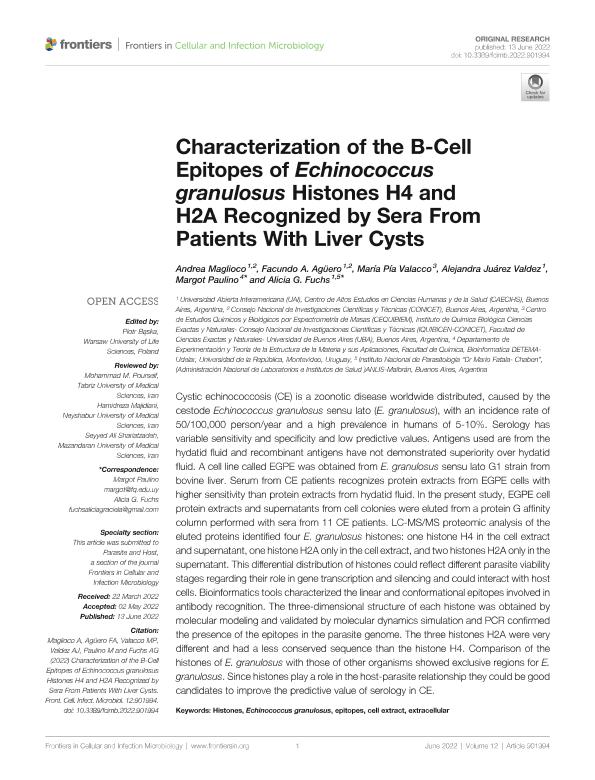Mostrar el registro sencillo del ítem
dc.contributor.author
Maglioco, Andrea Florencia

dc.contributor.author
Agüero, Facundo Ariel

dc.contributor.author
Valacco, Maria Pia

dc.contributor.author
Juarez Valdez, Alejandra Yaqueline

dc.contributor.author
Paulino, Margot
dc.contributor.author
Fuchs, Alicia Graciela

dc.date.available
2023-11-07T12:59:35Z
dc.date.issued
2022-06
dc.identifier.citation
Maglioco, Andrea Florencia; Agüero, Facundo Ariel; Valacco, Maria Pia; Juarez Valdez, Alejandra Yaqueline; Paulino, Margot; et al.; Characterization of the B-Cell Epitopes of Echinococcus granulosus Histones H4 and H2A Recognized by Sera From Patients With Liver Cysts; Frontiers Media; Frontiers in Cellular and Infection Microbiology; 12; 6-2022; 1-13
dc.identifier.issn
2235-2988
dc.identifier.uri
http://hdl.handle.net/11336/217279
dc.description.abstract
Cystic echinococcosis (CE) is a zoonotic disease worldwide distributed, caused by the cestode Echinococcus granulosus sensu lato (E. granulosus), with an incidence rate of 50/100,000 person/year and a high prevalence in humans of 5-10%. Serology has variable sensitivity and specificity and low predictive values. Antigens used are from the hydatid fluid and recombinant antigens have not demonstrated superiority over hydatid fluid. A cell line called EGPE was obtained from E. granulosus sensu lato G1 strain from bovine liver. Serum from CE patients recognizes protein extracts from EGPE cells with higher sensitivity than protein extracts from hydatid fluid. In the present study, EGPE cell protein extracts and supernatants from cell colonies were eluted from a protein G affinity column performed with sera from 11 CE patients. LC-MS/MS proteomic analysis of the eluted proteins identified four E. granulosus histones: one histone H4 in the cell extract and supernatant, one histone H2A only in the cell extract, and two histones H2A only in the supernatant. This differential distribution of histones could reflect different parasite viability stages regarding their role in gene transcription and silencing and could interact with host cells. Bioinformatics tools characterized the linear and conformational epitopes involved in antibody recognition. The three-dimensional structure of each histone was obtained by molecular modeling and validated by molecular dynamics simulation and PCR confirmed the presence of the epitopes in the parasite genome. The three histones H2A were very different and had a less conserved sequence than the histone H4. Comparison of the histones of E. granulosus with those of other organisms showed exclusive regions for E. granulosus. Since histones play a role in the host-parasite relationship they could be good candidates to improve the predictive value of serology in CE.
dc.format
application/pdf
dc.language.iso
eng
dc.publisher
Frontiers Media

dc.rights
info:eu-repo/semantics/openAccess
dc.rights.uri
https://creativecommons.org/licenses/by-nc-sa/2.5/ar/
dc.subject
CELL EXTRACT
dc.subject
ECHINOCOCCUS GRANULOSUS
dc.subject
EPITOPES
dc.subject
EXTRACELLULAR
dc.subject
HISTONES
dc.subject.classification
Tecnologías que involucran la identificación de ADN, proteínas y enzimas, y cómo influyen en el conjunto de enfermedades y mantenimiento del bienestar

dc.subject.classification
Biotecnología de la Salud

dc.subject.classification
CIENCIAS MÉDICAS Y DE LA SALUD

dc.title
Characterization of the B-Cell Epitopes of Echinococcus granulosus Histones H4 and H2A Recognized by Sera From Patients With Liver Cysts
dc.type
info:eu-repo/semantics/article
dc.type
info:ar-repo/semantics/artículo
dc.type
info:eu-repo/semantics/publishedVersion
dc.date.updated
2023-11-06T15:26:04Z
dc.journal.volume
12
dc.journal.pagination
1-13
dc.journal.pais
Suiza

dc.description.fil
Fil: Maglioco, Andrea Florencia. Universidad Abierta Interamericana; Argentina. Consejo Nacional de Investigaciones Científicas y Técnicas; Argentina
dc.description.fil
Fil: Agüero, Facundo Ariel. Universidad Abierta Interamericana; Argentina. Consejo Nacional de Investigaciones Científicas y Técnicas; Argentina
dc.description.fil
Fil: Valacco, Maria Pia. Consejo Nacional de Investigaciones Científicas y Técnicas. Oficina de Coordinación Administrativa Ciudad Universitaria. Instituto de Química Biológica de la Facultad de Ciencias Exactas y Naturales. Universidad de Buenos Aires. Facultad de Ciencias Exactas y Naturales. Instituto de Química Biológica de la Facultad de Ciencias Exactas y Naturales; Argentina
dc.description.fil
Fil: Juarez Valdez, Alejandra Yaqueline. Universidad Abierta Interamericana; Argentina
dc.description.fil
Fil: Paulino, Margot. Universidad de la República; Uruguay
dc.description.fil
Fil: Fuchs, Alicia Graciela. Dirección Nacional de Instituto de Investigación. Administración Nacional de Laboratorio e Instituto de Salud "Dr. C. G. Malbrán". Instituto Nacional de Parasitología "Dr. Mario Fatala Chaben"; Argentina
dc.journal.title
Frontiers in Cellular and Infection Microbiology
dc.relation.alternativeid
info:eu-repo/semantics/altIdentifier/doi/http://dx.doi.org/10.3389/fcimb.2022.901994
dc.relation.alternativeid
info:eu-repo/semantics/altIdentifier/url/https://www.frontiersin.org/articles/10.3389/fcimb.2022.901994/full
Archivos asociados
